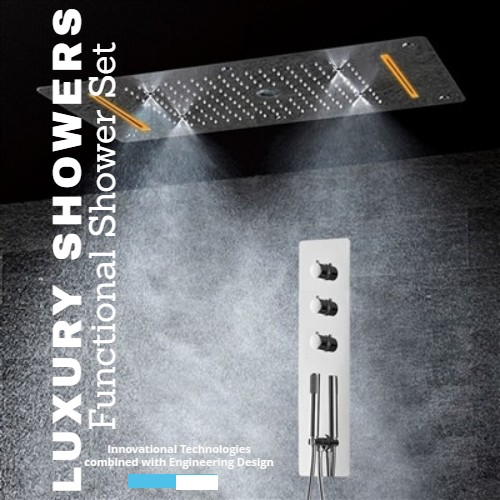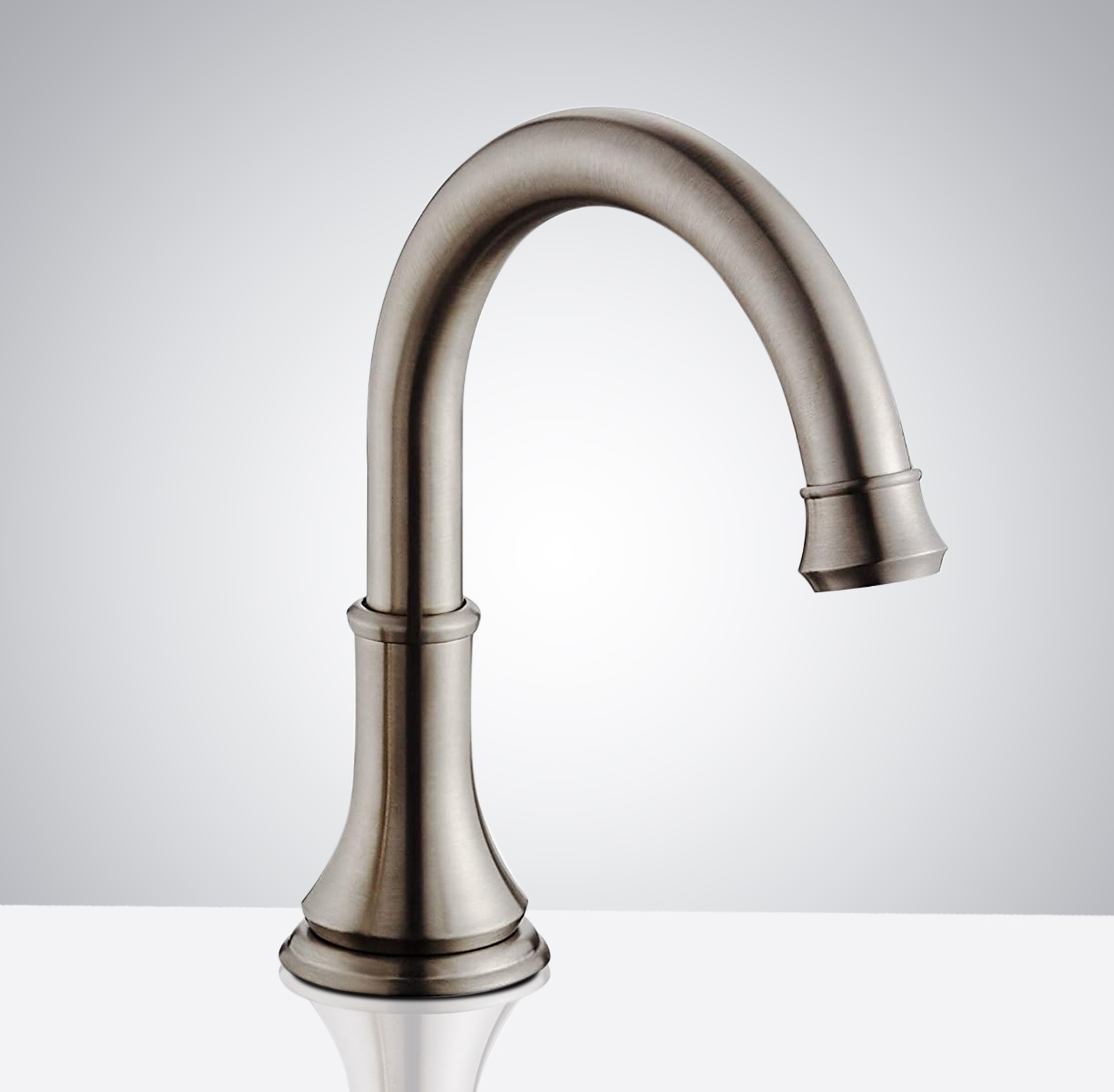Satin Nickel or Brushed Nickel bathroom fixtures
Brushed Nickel
 Satin Nickel vs Brushed Nickel!
Satin Nickel vs Brushed Nickel!
(updated April 2023)
Have you ever wondered about the differences between satin nickel and brushed nickel finishes? While both are popular for kitchens and bathrooms, each has unique pros and cons regarding durability, maintenance, style, and cost.
Are you curious about the disparities between satin nickel and brushed nickel?
Do you find it perplexing to differentiate or identify their similarities?
Are you uncertain about which one is more advantageous to utilize?
In this article will elucidate all these aspects and assist you in comprehending the disparities, similarities, suitable applications, and the pros and cons of each.
Although satin nickel vs brushed nickel may be simple to differentiate however each finish has its own unique pros and cons in terms of durability, maintenance, applications, style and pricing. To determine what is best for your bathroom or kitchen you can read below.
Brushed Nickel is referred to the metallic element used to make stainless steel (and other alloys) stronger and better able to withstand extreme temperatures and corrosive environments. On the other hand satin finish has no abrasion to its finish, and unlike brushed nickel, the satin finish is not a specific metallic element but a type of surface treatment applied to various metals, including stainless steel, aluminum, and titanium.
![]()
Satin finish involves a more straightforward process of sanding the metals surface, resulting in a smooth and consistent appearance. The finish is characterized by its low reflectivity and lack of shine, offering a subtle, soft sheen instead.
Looking for comparison of Satin Nickel vs Satin Brushed Nickel Bathroom Fixtures? satin nickel offers a more polished and reflective look, while brushed nickel provides a textured and muted appearance. Brushed Nickel a slightly matte appearance and a more subdued, understated look compared to the polished shine of satin nickel. Brushed nickel is often chosen for its ability to hide fingerprints, smudges, and scratches, making it a practical choice for high-traffic areas.
The bathroom shower system and shower fixtures hardware are available in various finishes, including brushed, satin, and chrome. Satin nickel is generally considered a subdued brass finish achieved through an electroplating process. It results in a dull appearance without the brushed texture, but rather a smooth texture. This finish is sometimes referred to as satin stainless steel. So, if your bathroom faucet is in brushed nickel and you are choosing a shower set, should you opt for a satin shower faucet or stick with brushed? BathSelect shower system offers three popular options: satin nickel, brushed nickel, and polished finishes. Nickel, for instance, provides both visual appeal and structural durability in shower hardware. It ages well and, with proper maintenance, can retain a nearly new look even after years of use.
.jpg)
Satin Nickel Vs. Brushed Nickel Shower System
Satin nickel isn’t technically a metal itself, but rather the nickel plating put on shower heads, shower arms, shower mixers and knobs with a zinc or brass base. It’s typically applied through electrolysis and then treated with a lacquer to dull the nickel’s usually shiny surface. Many showers, faucets, and fixture hardware consider satin nickel and brushed nickel to be the same finish.
Chrome vs. Brushed Nickel Bathroom Fixtures: What is the Difference?
Read more hereOil Rubbed Bronze vs. Matte Black Showers
Learn more hereBrushed Gold Shower Systems vs. Shiny Gold Shower Systems
Explore the article hereBrushed Nickel vs. Polished Nickel.
Read more hereBrushed Nickel Showers vs. Stainless Steel Showers
Learn more hereSatin Nickel or Brushed Nickel Bathroom Fixtures?
Explore here
Ultimately, the decision between Satin Nickel and Brushed Nickel comes down to your personal taste and the overall style of your bathroom. Consider the other finishes and fixtures in your bathroom and choose the one that complements them best. Both finishes can provide design beauty and durability to your shower system, so you can’t go wrong with either choice.
However true brushed nickel accessories are usually brushed with a tool (such as a wire brush), which creates small abrasions on the metal, all going in the same direction. This brushing technique removes some of the natural shine from the metal, although not to the extent of the lacquer found on satin nickel hardware.
On the other hand Polished nickel showers, faucets and hardware differs from satin and brushed nickel in terms of treatment. It does not undergo the same processes of lacquering or wire brushing that dull the shine. As a result, polished nickel retains a mirror-like shine that is comparable to chrome.
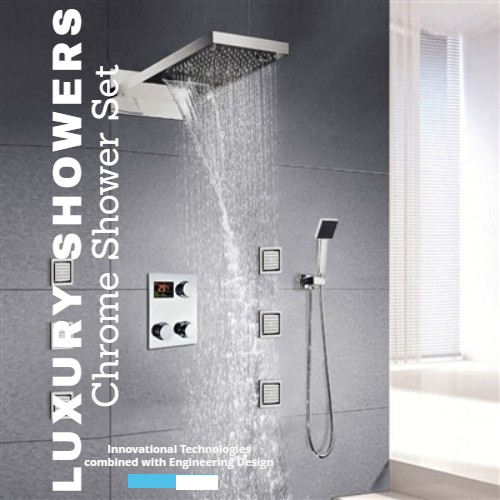
Cost comparison: While satin and brushed nickel are comparable in cost, both tend to be almost half the price of polished nickel handles, shower heads, and other fixtures. That extra shine adds some extra cash to the price tag!
Ability to Match – Most people give their bathrooms a facelift every 5-7 years. Some are small changes such as new paint color or just a new faucet or some other specific fixtures. Others may do a complete bathroom remodel jobs. Although some exceptions do exist, however in general satin nickel bathroom shower sets continue to complement most bathrooms.
On the other hand, polished nickel’s high shine doesn’t always adapt to a changing environment. In fact, polished nickel can look downright cheap if mismatched with non-complementary tile colors, decorative accent pieces and faucet fixtures. Over the long haul, satin nickel’s fresh, subdued look is more easily incorporated into other design schemes.
Regular Use Damage Potential – Satin nickel shower hardware’s medium sheen hides water spots, scratches and fingerprints. In contrast, polished nickel’s high shine cannot conceal even the tiniest of scratches, prints or spots. The same imperfection on brushed or satin nickel will generally not be noticeable at all.
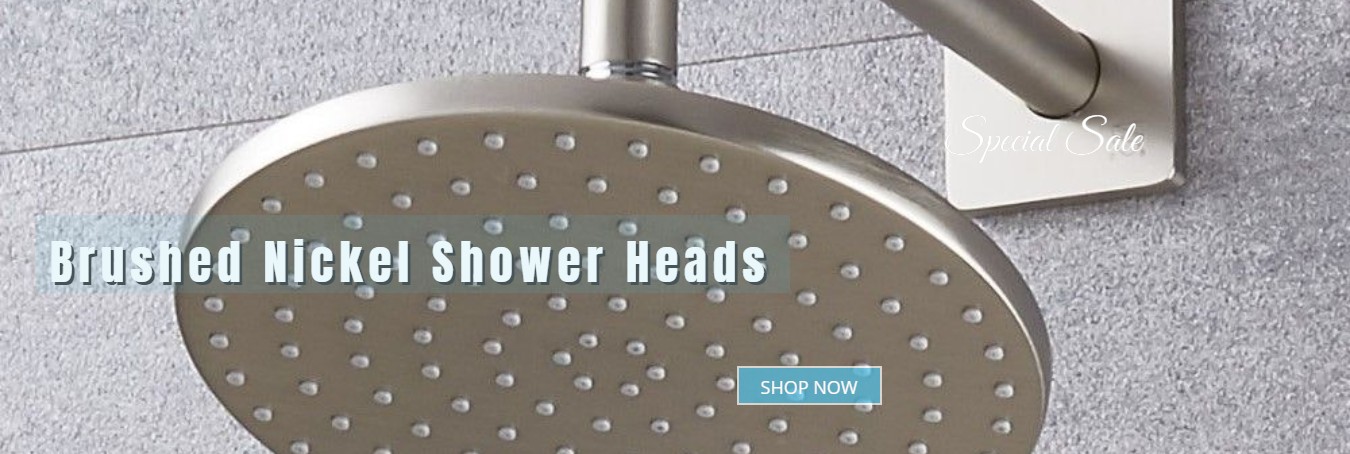
The Chrome faucets, shower head and shower set fixtures![]()
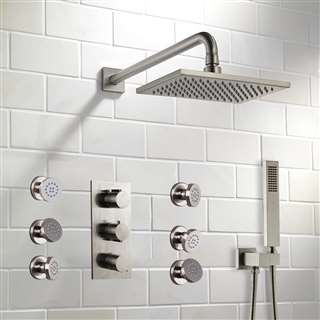
Brushed Nickel Thermostatic Shower Set with Pulsating Massage Body Sprays and Handheld are commonly used for walk in showers. The brushed nickel showers are easy to clean and maintain. The finish normally will stay in great condition the lifetime of the bathroom shower. Brushed nickel finish maintain its unique finish for a very long time. This brushed nickel thermostatic shower set with pulsating massage body sprays offers a combination of exquisite appeal, comfort, customizable features, and ease of use, making it an exceptional choice for a luxurious and enjoyable shower experience.
Chrome itself is commonly plated onto another metal such as copper or nickel to provide a little extra hardness and resistance as well as a shiny finish to the item. While chrome is primarily used for industrial purposes, the luster of chrome makes it a favorite for not only home fixtures but also for motorcycle engines and other automotive parts. Often a thin layer of chrome is applied over a thin layer of nickel, as both have high resistance to corrosion.
Nickel faucets, shower head, shower set, sensor faucet fixtures
Nickel’s high resistance to corrosion makes it ideal for mixing with other metals such as iron and brass. The majority of nickel manufactured in the world goes into making stainless steel. Nickel’s natural resistance to corrosion makes it a prime metal for use in home fixtures, as it is unlikely to rust or deteriorate from use.
Luxury Showers are available in Brushed Nickel Finish
The Brushed Metal faucets, shower head, and shower set bath fixtures
Brushed metal, be it nickel or chrome, refers to the method by which the metal has been finished. The term “brushed” refers to the appearance that a wire brush was used across the item, giving it directional abrasion lines after polishing. While “satin” or “velvety” metals include a smooth finish with no visible abrasions, brushed metals are meant to have a more handcrafted appearance that allows more interplay of light and shadow because of the rises within the surface.
Brushed Nickel Touchless Faucets
SELECTING TOUCHLESS FAUCETS FOR RESTROOMS
Discover our Large Selections of High Traffic Electronic Faucets.
Overall Experience for Commercial Bathroom are the needs for touchless heavy-duty faucets durable yet stylish.
FAQs
- Can I use vinegar to clean satin nickel or brushed nickel fixtures? It’s best to avoid using vinegar on satin nickel or brushed nickel fixtures, as it can potentially damage the finish. Stick to mild soap and water for routine cleaning.
- Is it necessary to use specific cleaning products for satin nickel and brushed nickel fixtures? Specific cleaning products are not necessary for routine maintenance. Mild soap and water are typically sufficient for cleaning both satin nickel and brushed nickel fixtures.
- Can I use a toothbrush to clean crevices on satin nickel? Yes, you can use a soft-bristle toothbrush to clean crevices on satin nickel fixtures. The soft bristles of a toothbrush are gentle enough to reach into tight spaces and remove dirt or grime that may accumulate in crevices.
Architectural Touchless Faucets for Public Restrooms
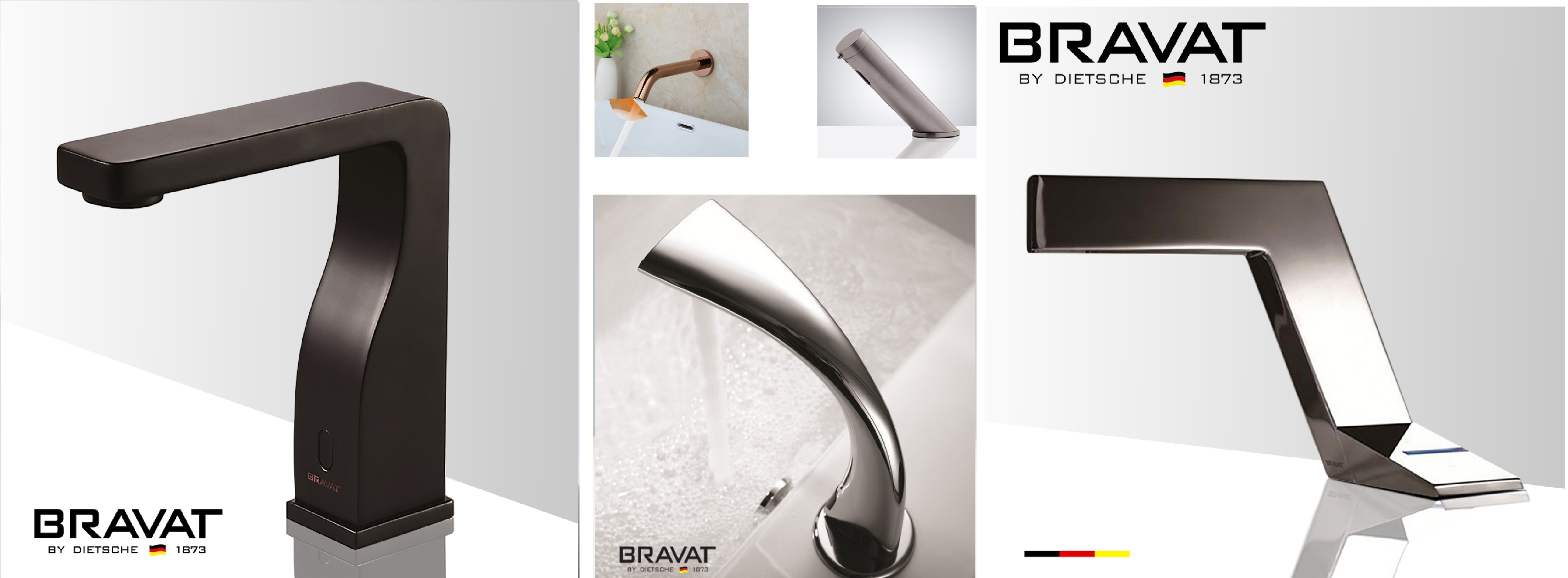
Improves Hygiene with Touchless Motion Activated Sensor Faucets
Primary differences of bathroom fixture finishes
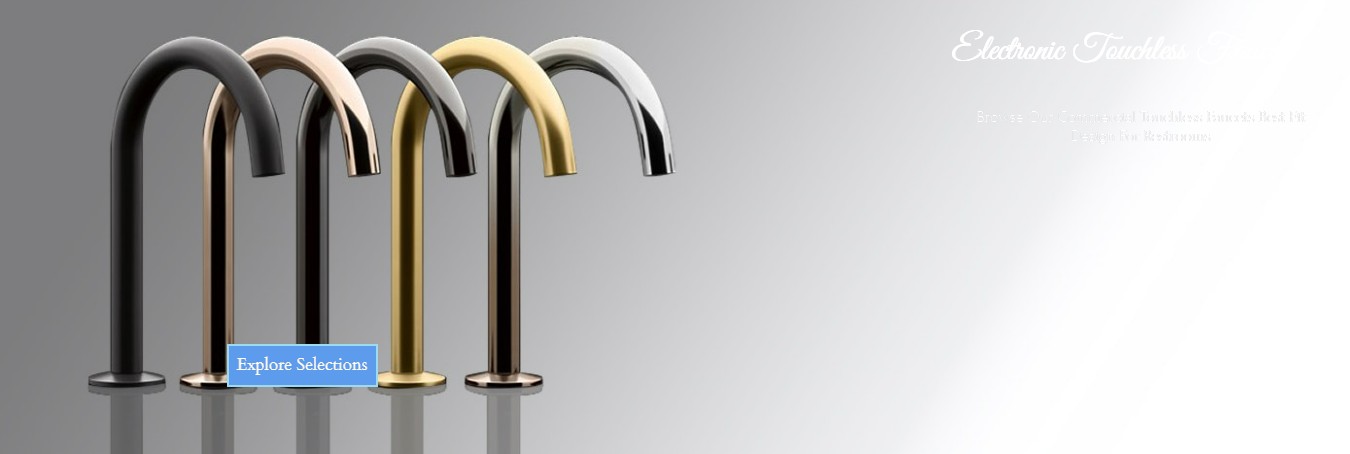
Brushed Nickel vs Satin Nickel
The main difference between Brushed Nickel and Satin Nickel lies in their texture and appearance. Brushed Nickel has a textured finish created by brushing the nickel surface with a wire brush or abrasive material. This process leaves fine lines or grooves on the surface, giving it a matte appearance. The brushed finish of Brushed Nickel provides a slightly duller and warmer look compared to Satin Nickel.
While brushed nickel and brushed chrome share many of the same properties, including a textured finished, the major difference between the two is in the tinting of the metal itself. Chrome plating gives metal a slight blue shine. Often this tinge is seen as giving a sophisticated and cool look to the finished piece. Nickel, on the other hand, has a natural yellow (or whitish) appearance.
This slight yellow hue is often seen as a warmer color than chrome’s blue. Varieties of Brushed nickel fixtures often come with a wider variety of finishes than brushed chrome. Chrome fixtures tend to have the same level of blue tint in every piece, while nickel ones appear more or less yellow depending on the amount of plating and density of the nickel used.
This means that fixtures from different manufacturers may take on a different appearance from each other despite being coated with brushed nickel. Selection Often selection between brushed nickel and brushed chrome comes down to price and appearance. Each metal is essentially just as durable and noncorrosive as the other; however, chrome is generally more expensive and offers a cooler appearance than the nickel.

In selecting between the two, consider the color of the surroundings; warmer colors, such as tan or earth tones, would look better with brushed nickel fixtures, while cooler colors, such as grey, blue or even white, may benefit from the bluish hue of chrome fixtures.
Similarly, because nickel has been historically used for metal finishing, it gives a more traditional, homey and antique look. On the other hand, chrome is a relatively modern addition and offers a more sophisticated, steely and modern look, following its rise in popularity for engines and other such decorative elements.
While both finishes are durable and resistant to scratches and corrosion, maintenance requirements may vary slightly. Satin Nickel finishes might require more careful cleaning to preserve their appearance, which could incur additional costs in the long run.
How to Care for the Satin Nickel Finish
The finish for Satin Nickel is perhaps the easiest of all the finishes, it is simply wiping dry with a soft cloth to prevent any water spotting and mineral build up over time. There are also available in the market few polishes that contains gentle cleaning and wax coating which are made specifically for the Satin Nickel Finish.
Here are few more images for you to differentiate between the Satin Nickel faucets vs Brushed Nickel faucets:
Example of Brushed Nickel Faucet Finish
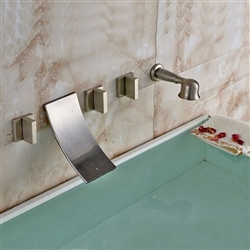 Brushed Nickel Finish With Triple Handle
Brushed Nickel Finish With Triple Handle
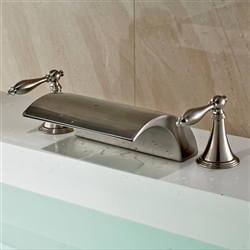 Deck Mount Brushed Nickel LED Bathtub Faucet
Deck Mount Brushed Nickel LED Bathtub Faucet
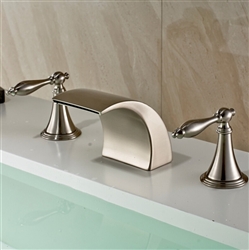 Nîmes Brushed Nickel Deck Mount Bathtub Faucet
Nîmes Brushed Nickel Deck Mount Bathtub Faucet
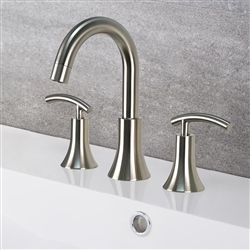 Créteil Brushed Nickel Bath Widespread Faucet
Créteil Brushed Nickel Bath Widespread Faucet
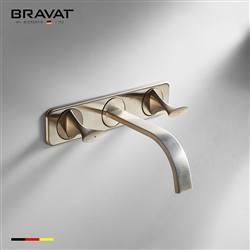 Bravat Brushed Nickel Bathroom Faucet
Bravat Brushed Nickel Bathroom Faucet
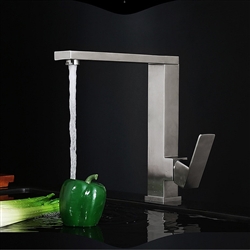 Sleek Design Faucet Deck Brushed Nickel
Sleek Design Faucet Deck Brushed Nickel
If you are concerned about visible fingerprints or water spots, brushed nickel may be a more forgiving choice.
Example of Satin Nickel Faucet Finish
Rio Contemporary Style Satin Nickel Finish
Satin nickel fixtures are particularly well-suited for bathrooms with neutral color schemes. Whether your bathroom features shades of white, gray, beige, or earth tones, satin nickel can seamlessly blend in and provide a cohesive and elegant look. It complements a wide range of colors and maintains a harmonious balance in the overall design.
Satin nickel finishes are known for their durability and resistance to tarnishing. Therefore, they are an excellent choice for high-traffic bathrooms such as those in hotels, resorts, or commercial establishments. Satin nickel fixtures can withstand frequent use and maintain their aesthetic appeal over time with minimal maintenance.

Satin nickel and brushed nickel offer distinct visual characteristics that can significantly impact the overall design of your bathroom. Whether you prefer the smooth elegance of satin nickel or the textured appeal of brushed nickel, consider your bathroom design, lighting, and maintenance preferences as to make an informed decision.
By choosing the right finish, you can create a cohesive and visually pleasing bathroom space that reflects your personal style.
The Different Advantages of Satin Nickel vs. Brushed Nickel Bathroom Fixtures
Satin nickel and brushed nickel are two popular bathroom fixture options known for their elegant and contemporary appeal. While they share similarities, there are subtle differences between the two. Understanding the advantages of satin nickel and brushed nickel can help you make an informed decision. Let’s explore the unique benefits of each finish:
Satin Nickel Bathroom Fixtures
- Smooth and Lustrous Finish: Satin nickel has a smooth and lustrous appearance that adds a touch of sophistication to any space. It has a slightly glossy sheen, but it’s not as reflective as polished finishes like chrome. This characteristic makes satin nickel an excellent choice for those seeking a more understated and subtle look.
- Versatility: Satin nickel complements various design styles, from modern to traditional. It has a neutral tone that pairs well with different color palettes and materials, making it a versatile option for creating a cohesive and harmonious aesthetic in your bathroom.
- Hide Imperfections: Satin nickel’s smooth finish is effective at concealing fingerprints, water spots, and minor scratches. This quality makes satin nickel fixtures relatively low-maintenance, as they require less frequent cleaning and upkeep compared to finishes that show marks more easily.
- Resistance to Tarnish: Satin nickel finishes are generally resistant to tarnishing, ensuring that your fixtures maintain their beauty and shine over time. They are less prone to oxidation and discoloration, providing a long-lasting and durable solution for your bathroom hardware needs.
Brushed Nickel Bathroom Fixtures
- Soft and Warm Appearance: Brushed nickel has a distinctive matte finish with fine brush marks or lines, creating a textured and warm appearance. This finish adds depth and character to bathroom fixtures, making them stand out as a focal point in your space. Brushed nickel’s unique texture gives it a slightly more casual and rustic vibe compared to satin nickel.
- Conceal Minor Scratches: The brushed texture of brushed nickel helps to hide minor scratches and wear, making it an excellent choice for high-traffic areas or fixtures that are subject to regular use. This quality contributes to the longevity and durability of brushed nickel finishes.
- Easy Maintenance: Brushed nickel fixtures are relatively easy to clean and maintain. Regular wiping with a soft cloth or sponge and mild soap and water is usually sufficient to keep the finish looking its best. Avoid using abrasive cleaners or scrub brushes that could potentially damage the brushed surface.
- Contemporary Appeal: Brushed nickel’s textured and modern appearance is well-suited for contemporary and transitional design styles. It can add a sleek and sophisticated touch to your bathroom while still maintaining a warm and inviting atmosphere.
Both satin nickel and brushed nickel finishes offer unique advantages, and the choice ultimately depends on your personal preference and the desired aesthetic for your bathroom. Consider factors such as the overall style of your space, maintenance requirements, and the level of shine and reflectiveness you desire.
Remember, whether you opt for satin nickel or brushed nickel, both finishes provide durability, resistance to tarnish, and a stylish appeal that can elevate the look and feel of your bathroom.
FAQs
- Can I mix satin nickel and brushed nickel finishes in my bathroom? Yes, you can mix satin nickel and brushed nickel finishes to create a visually interesting contrast. However you will need to ensure that the combination maintains a cohesive design and doesn’t create an overwhelming clash.
- Which finish is more popular in a contemporary bathroom design? Both satin nickel and brushed nickel finishes are popular choices for contemporary design. However, brushed nickel is often favored for its slightly more rustic and textured appearance.
- Does satin nickel and brushed nickel require special cleaning methods? Avoid using abrasive or sharp objects on both satin nickel and brushed nickel fixtures to prevent scratching or damaging the finish. Also, wipe up spills or water droplets promptly to minimize the chance of water spots or stains. Steer clear of harsh chemicals, acidic cleaners, and abrasive materials that can damage the finish. Stick to mild soap, warm water, and non-abrasive cleaning solutions specifically formulated for bathroom fixtures.
- Which finish tarnishes faster over an extended period of time; satin nickel or the brushed nickel? Although both finishes are designed to maintain their appearance over an extended period of time, however, if we were to compare the two finishes, satin nickel tends to show signs of tarnishing more quickly than brushed nickel. Since the satin nickel has a lacquer treatment to its nickel plating, so over time, these contaminants can accumulate creating a dull or tarnished appearance on the satin nickel surface. While on the other hand the brushed nickel has a slightly more durable finish due to the brush strokes and texture applied to the nickel surface. The brushed texture helps to mask and retain original appearance for a longer period of time compared to satin nickel.
Although Satin Nickel and Brushed Nickel may appear the same, however they differ in terms of their maintenance requirements and manufacturing process. Satin nickel usually show smoother look and appearance with no visible sign of abrasions verses the Brushed Nickel which due to intricate brushing process may show abrasion finish.
Can you mix and match with Brushed Nickel?
As a rule of thumb if you can create a good contrast to your bathroom fixtures then you have made a beautiful statement. Based on latest trends no need to stick to one specific finish across all your bath fixture project, since this may cause a dull look to your bath fixtures. However on the other side you must be careful in selecting those different contrast accent finish fixtures by identifying what goes with which finish. Again by doing so you will need to avoid the don’ts which are unacceptable options. For example a double vanity sink must include two identical faucets and same finish ( gold, chrome, bronze, brushed, etc.) Any difference is not acceptable. While the difference in the bath fixture finish brings an accent / contrast that will create a bold statement.

For example you can have you bath faucet(s) in chrome while the shower system in brushed nickel, or you can have the Shower system in oil rubbed bronze while the faucets in Venetian gold. You can also mix the black bathtub faucet with gold sink faucets. Also you can mix brushed nickel shower system with gold faucets.
Satin nickel and brushed nickel are popular finishes for bathroom fixtures such as faucets, shower heads, and towel bars. Both finishes offer a similar look and feel, with a subtle texture that gives a modern and stylish look to any bathroom.
Satin nickel has a smooth and consistent finish that is easy to clean and maintain. It has a soft and warm appearance that can complement a wide range of bathroom styles and decor. Satin nickel is also resistant to tarnishing and corrosion, making it a great option for high-use areas such as the bathroom.
Brushed nickel, on the other hand, has a more textured finish that gives a subtle matte look. It has a similar texture as the satin nickel but is a little more subtle, which gives a unique look. Brushed nickel is also known for its durability and resistance to tarnishing and corrosion.
Both finishes are versatile and can match well with different bathroom styles and decor. They can be paired with other materials such as chrome, glass, and ceramic to create a cohesive and stylish look.
In conclusion, both satin nickel and brushed nickel are great options for bathroom fixtures. They offer a modern and stylish look and are durable, easy to maintain and match well with various bathroom styles and decor. The choice between the two often comes down to personal preference and the look you want to achieve in your bathroom.

Satin Nickel
So what is satin nickel is it same as brushed nickel finish or is it different? The satin nickel is a matte finish and it has less texture vs the brushed one, furthermore the satin has no shine whether under direct sunlight or dim light environment. it has more hue to it and it is less abrasive compared to the brushed. Here are few examples of the most popular satin nickel finish:
Satin Nickel Sink Faucets
Satin nickel is becoming the leading pick over other sink faucet finishes, it shows smoother appearance with no abrasions verses the brushed nickel.
Does Nickel Tarnish?
While nickel is known for its resistance to corrosion, it can still undergo tarnishing under certain conditions. Factors such the specific alloy composition, surface finish, and the surrounding environment; as exposure to moisture, chemicals, air pollutants, and acidic substances can contribute to the tarnishing of nickel surfaces. However, compared to other metals, nickel has relatively good tarnish resistance and can maintain its appearance with proper care and maintenance. Regular cleaning and avoiding prolonged exposure to harsh elements can help minimize tarnishing and keep nickel surfaces looking their best.
Brushed Nickel vs Satin Nickel Which one to choose?
When deciding between brushed nickel and satin nickel, which finish should I choose? It’s always good idea to consider samples of both finishes to get a better sense of how they will look in your specific bathroom space. it is highly recommended to obtain samples of both options. By doing so, you can better assess how each finish will appear within your particular bathroom space. It’s important to note that lighting conditions, including natural sunlight, can have an impact on the visual outcome of the finish. By evaluating these samples in your bathroom’s lighting, you can make a more informed decision and ensure the chosen finish complements your desired visual appeal. Ultimately, the decision between Brushed Nickel and Satin Nickel comes down to your personal style, maintenance considerations, and how well the finish complements the overall design scheme.
This article covered the following topics:
| satin nickel |
| satin nickel vs brushed nickel |
| brushed nickel vs satin nickel |
| brushed nickel bathroom accessories |
| satin vs brushed nickel |
| satin nickel vs brushed |
| is satin nickel same as brushed nickel |
| satin nickel finish |
| difference between brushed nickel and satin nickel |
| how to clean brushed nickel |
| polished nickel vs satin nickel |
| satin nickel color |
| how to clean brushed nickel faucets |
| brushed vs satin nickel |
| color satin nickel |
| does nickel tarnish |
| satin nickel vs polished nickel |
| difference between satin nickel and brushed nickel |
| nickel brushed finish |
| brushed nickel cleaner |
| what is the difference between satin nickel and brushed nickel |
| brushed satin nickel |
| whats the difference between brushed nickel and satin nickel |
| whats the difference between satin nickel and brushed nickel |
| satin nickel vs brushed stainless steel |
| brushed nickel vs. satin nickel |
| satin nickel versus brushed nickel |
| difference between satin and brushed nickel |
| what color is satin nickel |
| brushed satin |
| difference between brushed and satin nickel |
| are brushed nickel and satin nickel the same |
| is satin nickel and brushed nickel the same |
| nickel vs brushed nickel |
| satin nickle vs brushed nickle |
Best Independent Reviews of Over 5 Faucet Brands Independent reviews of faucet brands ensure a better benchmark in evaluating the quality, durability, and functionality of products in this competitive bathroom fixture market. Being among the top five faucet brands, critical factors include material composition, finish durability, ease of installation, and water-saving technologies. Brands like Moen, Kohler, and Delta are more often than not hailed for their superior engineering, with many models boasting ceramic disc valves that eliminate leaks and increase the life of the faucet. Others, like FontanaShowers, have been known for their innovation in using touchless technology with the inclusion of motion sensors for better hygiene in high-traffic commercial settings. Water conservation is another important aspect, whereby a good number of brands make use of EPA WaterSense standards to ensure adequate water application without compromising on performance. While the reviewers have gone through analyzing these brands, they have repeatedly pointed out the balance between aesthetics and functionality, with finishes such as brushed nickel, oil-rubbed bronze, and polished chrome among others, playing an essential role in longevity and style. It examines the individual performance, but also the long-term reliability, the service experience for customers, and the ease of maintenance. This review therefore provides the customer with a comprehensive view of the best choices available in the market.
Polished Nickel vs. Chrome The polished nickel and chrome are two popular finishes with differences concerning visual and technical aspects in bathroom fixtures. Polished nickel is manufactured through an electroplating process in which nickel is plated onto a base metal that is then polished to give it a warm, high-luster sheen. Such finishes are very versatile, offering just the right balance between modernity and traditional feel. Because of its nature, it tends to be more resistant to tarnish than chrome but requires more frequent cleaning to maintain its high shine. Chrome, on the other hand, is a product of electroplating a layer of chromium onto a metal surface, and it exudes a highly reflective, mirror-like finish. Chrome fixtures boast a modern, sleek look that is easy to clean and durable; hence, they should perform quite well in high-traffic bathrooms. Technically speaking, chrome offers greater scratch and corrosion resistance due to the protective oxide layer formed on the surface of the material. However, chrome shows more tendency to watermark and fingerprint than polished nickel and may require more maintenance. Which of the two is used seems to mostly depend on the style one is aiming for and conditions of the area where it is being installed.
Shower Panel Simple Installations Shower panels are increasingly popular for their ease of installation and transforming a bathroom into a functional and aesthetic space. In most cases, these integrated systems will feature the rainfall shower head, body jets, and a handheld shower wand. Getting this all into one unit has significantly reduced the hassle of installation because multiple functions have been combined into one place. The secret behind their ease of installation lies in the design, where most of them have already set up connections that can be directly connected to the wall with no major plumbing modification. Many of the models are designed for retrofit applications; they can be installed over existing plumbing fixtures, which saves time and reduces labor costs. Technically speaking, the installation is supposed to involve connecting the panel to the already existing water supply lines and mounting it to the wall with the use of usually basic tools and negligible expertise. Some models with thermostatic valves further simplify user experience by allowing precise regulation of temperature. Quick installation makes the shower panels an excellent choice for bathroom renovations or upgrades when time and budgets are at a premium, to offer modern spa-like experiences without the hassle entailed in traditional shower system setups.
Best Shower Heads High Pressure High-pressure shower heads have been designed to produce a strong stream of water at low-pressure conditions to allow an invigorating and satisfying shower experience. The best high-pressure showerheads do this by using advanced nozzle designs in concert with air-infused technology to maximize the water pressure without increasing overall water consumption. Smaller, well-designed nozzles in some models can focus the water into concentrated jets that intensify the flow. Other units employ air-injection technology that mixes air with water to create larger droplets that feel more forceful while maintaining a lower flow rate to meet regulatory standards such as WaterSense. Other features contributing to them being highly functional are the adjustable settings of massage and jet modes. Most of these high-pressure shower heads are made from durable materials such as brass or stainless steel, which do not easily corrode, hence offering services for a long period. Besides, high-pressure shower heads could be fitted with self-cleaning nozzles that prevent mineral buildup, hence consistent performance. With these features, they can be very useful, especially where water pressure is low. They ensure comfort and water efficiency.
The Worst Bathroom Faucet 2025 The worst bathroom faucet in 2025 might be the one bedeviled by poor design, substandard materials, or insufficient functionality. Faucets prone to frequent leakage, corrosion, or finish degradation would acquire this status with ease, considering the expenses that their repairs or replacements involve. Every faucet that is fabricated from low-quality plastic or poorly cast metal will fail much sooner with standard use in high-moisture environments, such as bathroom use. Besides, faucets with now-antiquated valve technologies-like compression valves that wear out easily-will face a hard time competing against modern alternatives that boast the new generation of ceramic disc valve options for enhanced sturdiness and leak resistance. Another major issue could be finishes that discolor or chip rather easily, especially those subjected to tough cleaners or even hard water. Any faucets that do not utilize water-saving features, such as aerators or flow restrictors, would also be classed as inefficient and eco-unfriendly, further adding to poor ratings. A faucet with the combination of these negative attributes will surely cause frustrating usage and hence is not a good investment for residential and commercial purposes.
How to Increase Water Pressure in Shower in Apartment Increasing water pressure in an apartment shower can be quite challenging, especially when the building has an older plumbing system; nevertheless, there are some technical solutions that really can make a difference. First of all, it is the easiest solution to change the existing shower head with some high-pressure model, which would improve the water flow even in low-pressure conditions of the environment. Look for shower heads with air-injection technology that mixes water and air together to provide a stronger spray without using more water. Another solution would be to check if there are any flow restrictors inside the shower head, because these are usually fitted into showers to minimize water usage but can be detrimental to the water pressure. Sometimes these can be removed or changed to allow more water to pass through. In certain cases, the water pressure dilemma in such an apartment is either with the clogged pipes or with mineral buildup in the shower head itself, so cleaning or replacing old fixtures could be all it takes to improve performance. For inherently low water pressure situations within an apartment building, a water pressure booster pump may prove indeed to be long-lasting medicine; however, this generally needs the management’s approval. What’s more, checking that leakages or blockages of any kind do not take place inside the apartment plumbing will go a long way in ensuring maximum water pressure inside the fixtures.
Bath Fixtures: What Are the Major Finishes? Bath fixtures come in an enormous amount of finishes, which range from aesthetic advantages to functional ones. To that effect, some common finishes one is likely to encounter include chrome, brushed nickel, oil-rubbed bronze, polished nickel, and stainless steel. Chrome is very shiny and gives a very sleek, modern look. However, it requires frequent cleaning to avoid water spots and fingerprints. On the other hand, brushed nickel is warm with a matte finish and can tolerate smudges and fingerprints. Thus, it is very popular in high-traffic areas. Oil-rubbed bronze has a rich, dark color with heavy copper undertones, making it a great fit in traditional or rustic bathrooms. Special care is required for maintenance to keep the patina intact. Polished nickel is much more luxurious and warm, looking like chrome, but it also shows fingerprints and water spots quite easily. Stainless steel is strong and corrosion-resistant, usually reserved for contemporary or industrial design; it’s all about durability and low maintenance. Each finish maintains different characteristics related to durability, maintenance, and style; thus, one has to choose one’s finish in accordance with the particular demands of the bathroom environment.
Oil Rubbed Bronze LED Shower Head: How to Maintain Care for the oil-rubbed bronze LED shower head is a delicate balance between detailed cleaning and periodic maintenance that needs to be done to preserve not just the finish but also the functionality of the LED components. With its deep, rich tone, the oil-rubbed bronze finish-with subtle copper highlights-does present a potential problem insofar as tarnishing can easily occur unless properly cared for. To maintain the finish, it is recommended to avoid harsh chemical cleaners that strip the protective coating from the finishes but instead to use gentle cleaning solutions, such as water and mild soap. Cleaning regularly is a must, as water spots and mineral build-up will alter the finish over time. The LED component, which for the most part relies on water flow, every now and then needs to be checked so that nothing is clogged, because even low water pressure may affect the lighting system. Sometimes, the LED lights can malfunction due to mineral buildup in the water impeding the circulation of it via the turbine that powers them. Cleaning nozzles and maintaining consistent water pressure can extend the life of a shower head and an LED lighting system.




